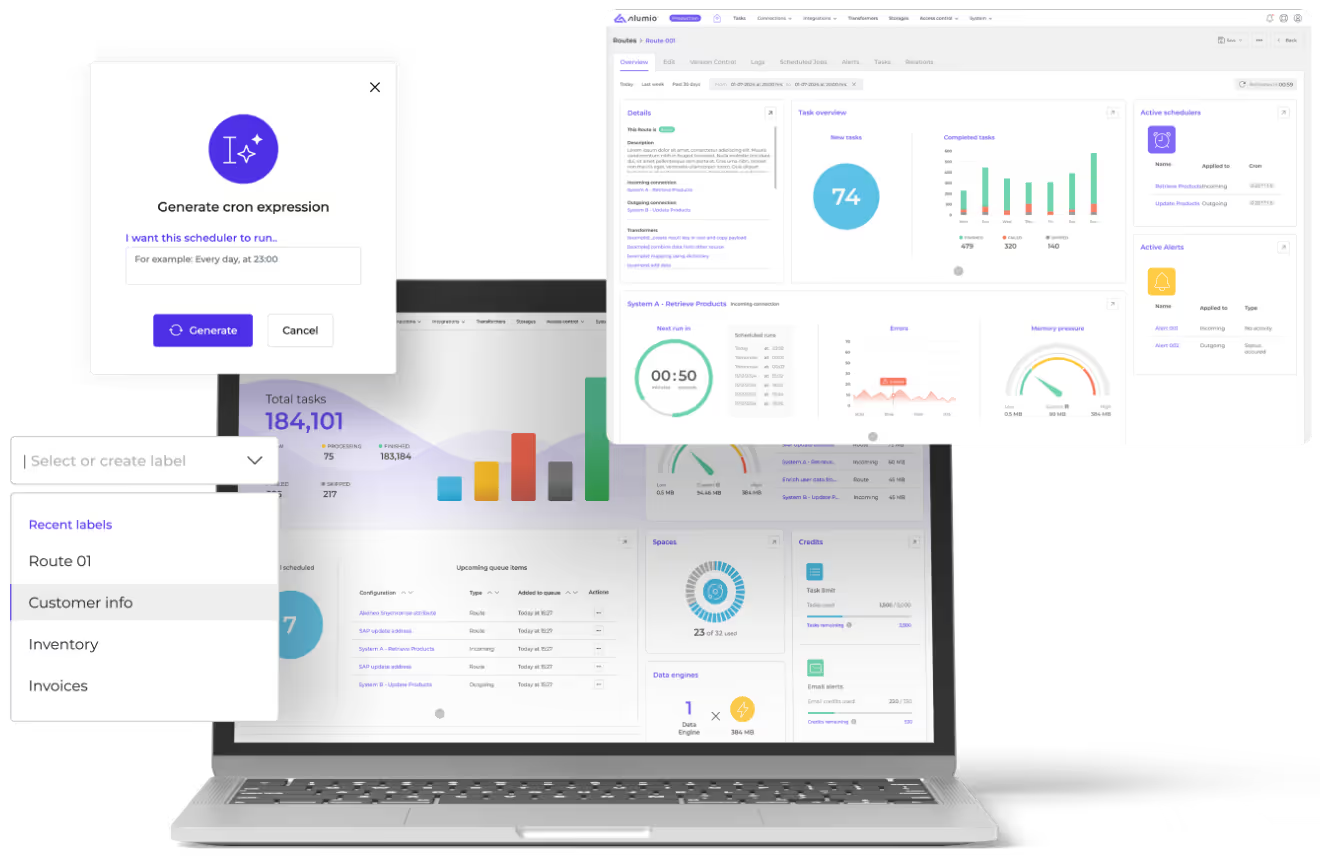Real-time data integration vs. Batch integration
Deciding on a specific integration method can make or break your operations. Real-time data integration offers immediate updates and responsiveness, ideal for dynamic environments. Batch integration, on the other hand, processes data at scheduled intervals, ensuring thoroughness and efficiency. Let’s explore the strengths and weaknesses of both approaches to help you decide the best fit for your business needs.
What is real-time data integration?
Real-time data integration, on the other hand, involves processing data as it is generated or received, without any delay. This approach ensures that data is available for consumption immediately after its creation. As such, the main goal of real-time data integration is to provide users and applications with up-to-date and accurate information, enabling organizations to make time-sensitive and educated decisions based on the latest information available. Real-time data integration also equips organizations with the ability to better respond to changing market conditions and shifting customer needs, contributing to both their agility and competitive edge.
Real-time data integration frequently involves the use of specialized software platforms and tools that can handle high volumes of data and endorse real-time processing and delivery. These platforms and tools typically provide other crucial data processing capabilities such as data mapping and transformation. Alumio is a perfect example of this.
What is the role of real-time data processing in our everyday lives?
Although we may not realise, real-time data processing is everywhere we look, facilitating immediate access to information and enabling seamless interactions across various applications and devices. Here are some common examples of real-time data processing in everyday scenarios:
Online shopping: When you browse an e-commerce website, the site dynamically updates product availability, pricing, and recommendations in real-time based on your browsing history, preferences, and inventory status.
Traffic management systems: Urban traffic management systems use real-time data from sensors, cameras, and GPS devices to monitor traffic flow, detect congestion, and optimize signal timing to minimize delays and improve traffic efficiency.
Social media feeds: Social media platforms such as Facebook, X, TikTok, and Instagram employ real-time data processing to curate personalized feeds. Content is continuously analyzed and prioritized based on factors like relevance, engagement, and timeliness to deliver an up-to-date user experience.
Stock market trading: In the financial sector, real-time data processing is critical for stock market trading. Traders rely on real-time market data feeds to monitor stock prices, analyze market trends, and execute trades swiftly to capitalize on market fluctuations.
These are just a few examples of the role real-time data processing plays in our every day lives. Other examples include automated teller machines (ATMs), smart home devices like thermostats, security cameras, and lighting systems, or health monitoring apps that monitor vital signs and track physical activity. The common denominator in all of these cases is the fact that each system needs to make use of this data in real-time, which is why it needs to be processed as quickly as possible.
Key benefits of real-time data integration:
- Timely decision-making: Real-time integration provides instantaneous access to critical data, enabling organizations to make informed decisions in the moment, driving agility and responsiveness.
- Enhanced customer experience: By delivering data in real-time, organizations can personalize customer interactions, respond promptly to inquiries, and provide seamless transaction experiences.
- Optimized operational efficiency: Real-time integration streamlines business processes by eliminating latency in data availability, fostering operational efficiency and reducing bottlenecks.
- Improved data accuracy: With data processed immediately, real-time integration minimizes the risk of data staleness and ensures data accuracy, laying the foundation for confident decision-making and strategic insights.
What is batch data integration?
Batch data integration entails the consolidation and processing of data in predefined batches at scheduled intervals. This approach accumulates data over a period, often hours or days, before transferring it en masse to the target system for processing. Batch integration is well-suited for scenarios where immediate data availability is not critical.
What are some day-to-day examples of batch data processing?
Batch data processing is a method of processing large volumes of data in predefined batches, typically at scheduled intervals or when a specific amount of data has been accumulated. This approach is commonly used in various everyday scenarios where immediate data processing is not required. Here are some examples of batch data processing in daily life:
Banking transactions: At the end of each business day, banks often process a batch of transactions, including deposits, withdrawals, and transfers. These transactions are accumulated throughout the day and processed in a batch overnight, ensuring that account balances are updated accurately.
Credit card statements: Credit card companies generate statements for cardholders on a monthly basis. Transaction data, including purchases, payments, and fees, is collected and processed in batches at the end of each billing cycle to generate monthly statements for cardholders.
Utility billing: Utility companies, such as electricity, water, and gas providers, typically generate billing statements for customers on a monthly basis. Consumption data from meters is collected over the billing period and processed in batches to calculate charges and generate invoices for customers.
Email marketing campaigns: Email marketing platforms often use batch data processing to send marketing emails to subscribers. Subscriber lists and email content are processed in batches at scheduled intervals to send out bulk emails to recipients, ensuring efficient delivery and tracking of campaign performance.
Key benefits of batch data integration:
- Efficiency in bulk processing: Batch integration efficiently handles large volumes of data, making it ideal for scenarios involving hefty data sets.
- Resource optimization: By processing data in predefined batches, batch integration minimizes resource contention and optimizes system performance.
- Simplified error management: With data processed in batches, it's easier to detect and rectify errors before data transfer, enhancing data integrity and reliability.
- Predictable workload: Batch processing enables organizations to schedule data tasks during off-peak hours, ensuring smooth operations without disrupting regular workflows.
Conclusion
Determining which integration approach suits you best hinges on a multitude of factors, including the volume of the data you want to process, the processing needs of your applications, and the cost implications of each approach, including infrastructure requirements, maintenance overhead, and potential downtime. Ultimately, real-time processing is the better fit for situations where continuous and up-to-date data output is needed, whereas batch processing is better suited to handling large volumes of data that are not time-sensitive. But one thing is for certain: both approaches play pivotal roles in driving organizational efficiency and enabling data-driven decision-making. By understanding the nuances of each approach and aligning them with unique business requirements, organizations can unlock the full potential of data integration and achieve their strategic objectives efficiently.

























